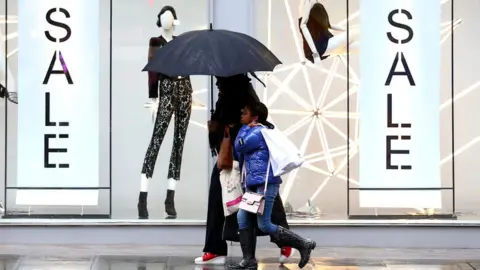Retail sales rebound in January as Omicron eases
 Getty Images
Getty ImagesUK retail sales rebounded by 1.9% in January as shoppers returned to the High Street after the Omicron disruption in December.
Department stores, garden centres and other non-food shops saw strong growth with a 3.4% rise, the Office for National Statistics (ONS) said.
However, food sales fell below their pre-pandemic level for the first time.
January's better-than expected growth followed a 4% fall in December when new pandemic restrictions were imposed.
ONS director of economic statistics Darren Morgan said January's rebound was "the biggest monthly rise since the shops reopened last spring".
He added: "It was a good month for garden centres, department and household goods stores, with particularly strong trading for furniture and lighting.
"Food sales fell below their pre-pandemic level for the first time, though, as more people returned to eating out and there was also anecdotal evidence suggesting higher demand for takeaways and meal-subscription kits."
A rise in High Street footfall towards the end of the month meant that the proportion of online sales dropped to its lowest level since March 2020, the ONS said.
Meanwhile, clothes stores reported a fall of 5% over the month and remain 12.6% below pre-pandemic sales levels. An increase in road traffic helped push fuel sales up from December.
Helen Dickinson, chief executive of the British Retail Consortium, said the retail figures "held up well" despite falling consumer confidence.
"Rising inflation means households may be preparing for future falls in disposable income, including from April's rise in National Insurance and the energy price cap.
"Retailers face similar challenges, with increases in transport and energy costs, global commodity prices and domestic wages," she said.
It was inevitable that retail prices will rise further, Ms Dickinson added.
Interest rates
"The solid rise in retail sales volumes in January adds to the signs that the Omicron-induced hit to activity was smaller and shorter-lived than previously thought. Even so, the cost of living crisis means the outlook for retailers is anything but bright," said Adam Hoyes, economist at Capital Economics.
The latest figures follow ONS data this week which confirmed the cost of living hit a fresh 30-year high in January as energy and food prices continued to soar and retailers reined in seasonal discounts.
The Bank of England predicts inflation - the rate at which prices are rising - will go from 5.5% currently to 7% by the spring.
It can try and use interest rates to make borrowing more expensive to dampen inflation. Earlier this month it increased interest rates from 0.25% to 0.5%.
Neil Birrell, chief investment officer at Premier Miton Investors, said the stronger data would add to the case for another interest rate rise next month.
"Given the rise in inflation and borrowing costs, as well as spikes in energy prices and tax increases, we are likely to see some patchy data in the coming months.
"However, as one of the key drivers of the economy overall, it is likely that this will help convince the Bank of England that the recovery will be able to cope with more interest rate rises." Mr Birrell said.
